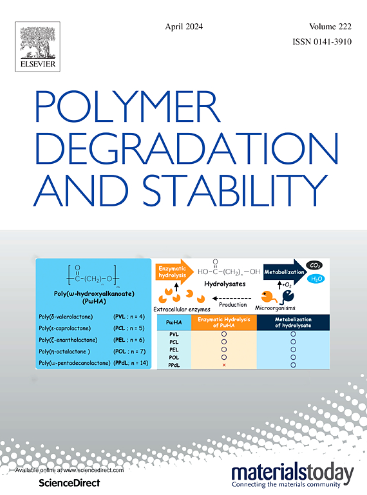Degradation of multicomponent phosphate-plasticized PVC under thermal aging at moderate temperature
IF 6.3
2区 化学
Q1 POLYMER SCIENCE
引用次数: 0
Abstract
Given the limited literature on the aging of multicomponent phosphate-plasticized polyvinylchloride (p-PVC), studies are needed to better understand the degradation mechanisms of such materials. To this end, p-PVC was formulated with three plasticizers: 12.5 % phosphate plasticizer, 17.5 % Diisodecyl Phthalate (DIDP), and 1.8 % Epoxidized Soybean Oil (ESBO). An additional 2.5 wt % of pigment paste was also added to half of the samples. To mimic real environment in which such materials can be present, the p-PVC films underwent artificial aging through temperature cycling (48 h at 80 °C, 24 h at 25 °C, with a constant relative humidity of 65 %). Yellowing was observed as the dominant colour change, with the metallic stabilizer contributing to a greenish hue at the start of aging. The study of plasticizer migration demonstrated that mainly the phosphate plasticizer was lost from the samples over 300 days of aging, while the DIDP and ESBO contents remained largely stable. Thus, phosphate diffusion coefficient in PVC of 4–6 × 10–15 m²/s has been measured, which has not yet been reported in the literature. Finally, the pigment showed no effect on dehydrochlorination nor plasticizer loss, but contributed to conceal the sample yellowing.
中温热老化下多组分磷酸盐增塑型PVC的降解研究
鉴于多组分磷酸盐增塑型聚氯乙烯(p-PVC)老化方面的文献有限,需要进一步研究这类材料的降解机制。为此,用三种增塑剂配制了对聚氯乙烯:12.5%磷酸盐增塑剂,17.5%邻苯二甲酸二异癸酯(DIDP)和1.8%环氧大豆油(ESBO)。另外的2.5 wt %的颜料膏也被添加到一半的样品中。为了模拟这种材料可以存在的真实环境,p-PVC薄膜通过温度循环进行人工老化(在80℃下48小时,在25℃下24小时,恒定的相对湿度为65%)。观察到黄变是主要的颜色变化,金属稳定剂在老化开始时产生绿色色调。增塑剂迁移研究表明,在300 d以上的时间内,增塑剂主要以磷酸盐为主流失,而DIDP和ESBO含量基本保持稳定。因此,磷酸盐在PVC中的扩散系数为4-6 × 10-15 m²/s,这在文献中尚未报道。最后,颜料对脱氢氯化和增塑剂损失没有影响,但有助于掩盖样品的变黄。
本文章由计算机程序翻译,如有差异,请以英文原文为准。
求助全文
约1分钟内获得全文
求助全文
来源期刊

Polymer Degradation and Stability
化学-高分子科学
CiteScore
10.10
自引率
10.20%
发文量
325
审稿时长
23 days
期刊介绍:
Polymer Degradation and Stability deals with the degradation reactions and their control which are a major preoccupation of practitioners of the many and diverse aspects of modern polymer technology.
Deteriorative reactions occur during processing, when polymers are subjected to heat, oxygen and mechanical stress, and during the useful life of the materials when oxygen and sunlight are the most important degradative agencies. In more specialised applications, degradation may be induced by high energy radiation, ozone, atmospheric pollutants, mechanical stress, biological action, hydrolysis and many other influences. The mechanisms of these reactions and stabilisation processes must be understood if the technology and application of polymers are to continue to advance. The reporting of investigations of this kind is therefore a major function of this journal.
However there are also new developments in polymer technology in which degradation processes find positive applications. For example, photodegradable plastics are now available, the recycling of polymeric products will become increasingly important, degradation and combustion studies are involved in the definition of the fire hazards which are associated with polymeric materials and the microelectronics industry is vitally dependent upon polymer degradation in the manufacture of its circuitry. Polymer properties may also be improved by processes like curing and grafting, the chemistry of which can be closely related to that which causes physical deterioration in other circumstances.
 求助内容:
求助内容: 应助结果提醒方式:
应助结果提醒方式:


